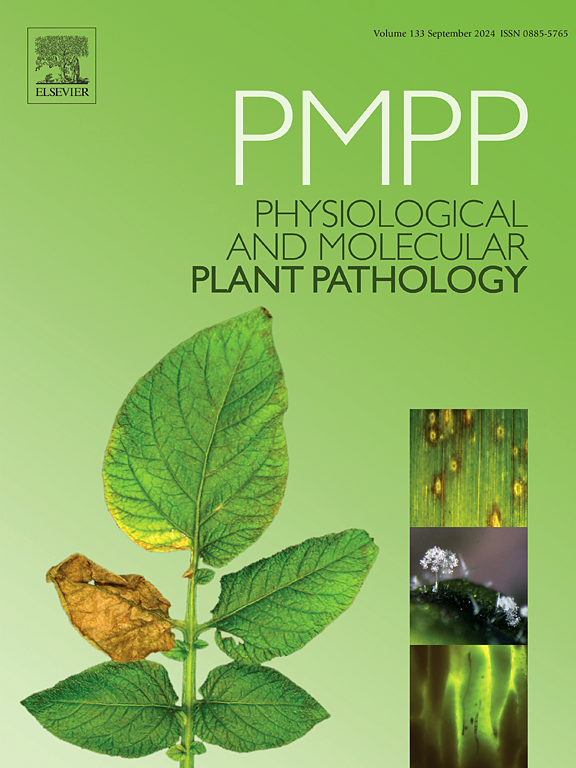番茄叶霉菌抗性基因 Cf-12 抵御 Cladosporium fulvum 的生理和转录组分析
IF 2.8
3区 农林科学
Q2 PLANT SCIENCES
引用次数: 0
摘要
由黄枝霉(C. fulvum)引起的番茄叶霉病是影响番茄最具破坏性的病害之一。C. fulvum进化得非常快。对黄腐菌有抗性的含Cf品种容易被新分化的生理小种侵染。本研究通过测定Cf-12植株和敲除系Slcf-12-28的生理生化指标,并在接种后进行转录组学分析,阐明Cf-12与黄颡鱼不亲和互作的分子机制。结果表明,Cf-12能快速识别黄芽孢杆菌分泌的效应物,并在感染部位诱导大量活性氧,导致抗氧化酶活性迅速升高,次生代谢过程中苯丙氨酸解氨酶、植物抗毒素、木素、酚类、黄酮类等抗菌物质积累。同时,诱导JA合成通路中AOS、AOC和OPR的上调,激活JA启动的早期抗性应答基因的表达。最后,黄芽孢杆菌感染点周围的细胞发生局部过敏性坏死,限制了黄芽孢杆菌的进一步感染。综上所述,这些结果有助于进一步了解Cf与C. fulvum不相容相互作用的分子机制。本文章由计算机程序翻译,如有差异,请以英文原文为准。
Physiological and transcriptomic analysis of tomato leaf mold resistance gene Cf-12 against Cladosporium fulvum
Tomato leaf mold caused by Cladosporium fulvum (C. fulvum, syn. Passalora fulva) is one of the most devastating diseases affecting tomatoes. C. fulvum evolves very fast. Cultivars containing Cf that are resistant to C. fulvum are easily infected by newly differentiated physiological races. In this study, physiological and biochemical indicators of Cf-12 plants and knockout lines Slcf-12-28 were determined, and transcriptomic analysis was performed after inoculation to elucidate the molecular mechanism of the incompatibility interaction between Cf-12 and C. fulvum. The results showed that Cf-12 could quickly recognize the effectors secreted by C. fulvum and induce a large number of reactive oxygen species at the infection site, which led to a rapid increase in antioxidant enzyme activities and the accumulation of antibacterial substances such as phenylalanine ammonia-lyase, phytoalexin, lignin, phenols, and flavonoids during secondary metabolism. At the same time, it induces the upregulation of AOS, AOC and OPR in the JA synthesis pathway, and activates the expression of early resistance response genes initiated by JA. Finally, local hypersensitive necrosis occurred in the cells around the infection points of C. fulvum, limiting further infection of C.fulvum. In conclusion, these results contribute to further understanding of the molecular mechanism of the incompatibility interaction between Cf and C. fulvum.
求助全文
通过发布文献求助,成功后即可免费获取论文全文。
去求助
来源期刊
CiteScore
4.30
自引率
7.40%
发文量
130
审稿时长
38 days
期刊介绍:
Physiological and Molecular Plant Pathology provides an International forum for original research papers, reviews, and commentaries on all aspects of the molecular biology, biochemistry, physiology, histology and cytology, genetics and evolution of plant-microbe interactions.
Papers on all kinds of infective pathogen, including viruses, prokaryotes, fungi, and nematodes, as well as mutualistic organisms such as Rhizobium and mycorrhyzal fungi, are acceptable as long as they have a bearing on the interaction between pathogen and plant.

 求助内容:
求助内容: 应助结果提醒方式:
应助结果提醒方式:


